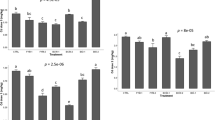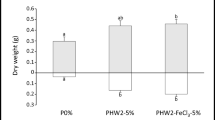Abstract
The carbon rich material obtained from pyrolysis process, i.e. biochar, has been widely discussed during the last decade due to its utilisation as a soil amendment. Furthermore, there is an unsolved question of biomass disposal from phytoremediation technologies. The idea of contaminated biomass pyrolysis has appeared, but there is lack of information about possible biochar utilisation obtained by this process. The aim of our study was to observe sorption properties of biochar prepared from contaminated biomass and release of contaminants from biochar back into the environment. The biomass of fast growing trees and maize was harvested on a site significantly damaged by risk element contamination (Cd, Pb and Zn). Plant biomass was pyrolysed and then the batch (de)sorption experiments were settled. The results confirmed no significant differences in metal sorption ability between biochars prepared from contaminated and uncontaminated biomass under the same conditions. The trend of maximum sorption capacity of observed matrices followed the order: wood biochar + soil (WB + soil) > wood uncontaminated biochar + soil (WUB + soil) > maize biochar + soil (MB + soil) > soil for cadmium, WB + soil > WUB + soil > soil for lead and MB + soil > WUB + soil > WB + soil > soil for zinc. Despite of increase of Zn desorption from wood biochars, maximum sorption capacity of the final WB + soil system was comparable to the WUB+soil sample. Our laboratory experiments showed high potential of biochar from contaminated plants as a soil amendment with sorption abilities and minimal risk of metal release.








Similar content being viewed by others
References
Anonymous, (1994). Public Notice No. 13/1994, regulating some details concerning the preservation of agricultural lands available. Czech Ministry of the Environment, Prague.
Bolster, C. H., & Hornberger, G. M. (2007). On the use of linearized Langmuir equations. Soil Science Society of America Journal, 71(6), 1796–1806.
Brunauer, S., Emmett, P. H., & Teller, E. (1938). Adsorption of gases in multimolecular layers. Journal of the American Chemical Society, 60(2), 309–319.
Cao, X., Ma, L., Gao, B., & Harris, W. (2009). Dairy-manure derived biochar effectively sorbs lead and atrazine. Environmental Science & Technology, 43(9), 3285–3291.
Chen, X., Chen, G., Chen, L., Chen, Y., Lehmann, J., McBride, M. B., & Hay, A. G. (2011). Adsorption of copper and zinc by biochars produced from pyrolysis of hardwood and corn straw in aqueous solution. Bioresource Technology, 102(19), 8877–8884.
Chun, Y., Sheng, G., Chiou, C. T., & Xing, B. (2004). Compositions and sorptive properties of crop residue-derived chars. Environmental Science & Technology, 38(17), 4649–4655.
CSN EN 15403 (2011). Solid alternative fuels—determination of ash. Prague, Czech Office for Standards, Metrology and Testing. (In Czech).
Fletcher, A. J., Smith, M. A., Heinemeyer, A., Lord, R., Ennism, C. J., Hodgsonm, E. M., & Farrar, K. (2014). Production factors controlling the physical characteristics of biochar derived from phytoremediation willow for agricultural applications. Bioenergy Resources, 7(1), 371–380.
Gaskin, J. W., Steiner, C., Harris, K., Das, K. C., & Bibens, B. (2008). Effect of low-temperature pyrolysis conditions on biochar for agricultural use. Transaction of American Society of Agricultural and Biological Engineers, 51(6), 2061–2069.
Hao, L., Song, H., Zhang, L., Wan, X., Tang, Y., & Lv, Y. (2012). SiO2/graphene composite for selective adsorption of Pb(II) ion. Journal of Colloid and Interface Science, 369(1), 381–387.
ISO 11260 (1994). Soil quality—determination of effective cation exchange capacity and base saturation level using barium chloride solution. American National Standards Institute.
Jiang, J., Xu, R. K., Jiang, T. Y., & Li, Z. (2012). Immobilization of Cu(II), Pb(II) and Cd(II) by the addition of rice straw derived biochar to a simulated polluted Ultisol. Journal of Hazardous Materials, 229, 145–150.
Kubešová, M., & Kučera, J. (2010). Validation of k0 standardization method in neutron activation analysis—the use of Kayzero for Windows programme at the nuclear physics institute, Řež. Nuclear Instruments and Methods in Physics Research A, 622, 403–406.
Langmuir, I. (1916). The constitution and fundamental properties of solids and liquids. Part I. Solids. Journal of the American Chemical Society, 38(11), 2221–2295.
Lehmann, J. (2007). Bio-energy in the black. Frontiers in Ecology and the Environment, 5(7), 381–387.
Lu, H., Zhang, W., Yang, Y., Huang, X., Wang, S., & Qiu, R. (2012). Relative distribution of Pb2+ sorption mechanisms by sludge-derived biochar. Water Research, 46(3), 854–862.
Mohan, D., Pittman, C. U., Jr., Bricka, M., Smith, F., Yancey, B., Mohammad, J., Steele, P. H., Alexandre-Franco, M. F., Gómez-Serrano, V., & Gong, H. (2007). Sorption of arsenic, cadmium, and lead by chars produced from fast pyrolysis of wood and bark during bio-oil production. Journal of Colloid and Interface Science, 310(1), 57–73.
Morley, J. (1929). Compost and charcoal. The National Greenkeeper, 3(9), 8–26.
Mustafa, S., Dilara, B., Naeem, A., Rahana, N., & Shahida, P. (2002). Sorption of metal ions on a mixed oxide [0.5 M SiO2:0.5 M Fe(OH)3]. Adsorption Science & Technology, 20(3), 215–230.
Nash, J. E., & Sutcliffe, J. V. (1970). River flow forecasting through conceptual models part I—a discussion of principles. Journal of Hydrology, 10(3), 282–290.
Němeček, J., Vácha, R., Podlešáková, E. (2010). Assessment of soil contamination in the Czech Republic. Research Institute for Soil and Water Conservation, Prague. (In Czech).
Novak, J. M., Busscher, W. J., David, L., Laird, D. L., Ahmedna, M., Watts, D. W., & Niandou, M. A. S. (2009). Biochar amendment on fertility of a southeaster coastal plain soil. Soil Science, 174(2), 105–112.
Pulford, I. D., & Watson, C. (2002). Phytoremediation of heavy metal-contaminated land by trees—a review. Environment International, 29(4), 529–540.
Qui, Y., Cheng, H., Xua, C., & Sheng, G. D. (2008). Surface characteristics of crop-residue-derived black carbon and lead (II) adsorption. Water Research, 42(3), 567–574.
Sas-Nowosielska, A., Kucharski, R., Malkowski, E., Pogrzeba, M., Kuperberg, J. M., & Krynski, K. (2004). Phytoextraction crop disposal—an unsolved problem. Environmental Pollution, 128(3), 373–379.
Sombroek, W. G. (1966). Amazon soils (Doctoral dissertation, Centre for agricultural publications and documentation).
Stals, M., Carleer, R., Reggers, G., Schreurs, S., & Yperman, J. (2010). Flash pyrolysis of heavy metal contaminated hardwoods from phytoremediation: characterisation of biomass, pyrolysis oil and char/ash fraction. Journal of Analytical and Applied Pyrolysis, 89(1), 22–29.
Šyc, M., Pohořelý, M., Kameníková, P., Habart, J., Svoboda, K., & Punčochář, M. (2012). Willow trees from heavy metals phytoextraction as energy crops. Biomass and Bioenergy, 37, 106–113.
Trakal, L., Komárek, M., Száková, J., Zemanová, V., & Tlustoš, P. (2011). Biochar application to metal-contaminated soil: evaluating of Cd, Cu, Pb and Zn sorption behavior using single- and multi-element sorption experiment. Plant, Soil and Environment, 57(8), 372–380.
Trakal, L., Komárek, M., Száková, J., Tlustoš, P., Tejnecký, V., & Drábek, O. (2012). Sorption behavior of Cd, Cu, Pb, and Zn and their interactions in phytoremediated soil. International Journal of Phytoremediation, 14(8), 372–380.
Tryon, E. H. (1948). Effect of charcoal on certain physical, chemical and biological properties of forest soils. Ecological Monographs, 18, 81–115.
Uchimiya, M., Wartelle, L. H., Klasson, K. T., Fortier, C. A., & Lima, I. M. (2011). Influence of pyrolysis temperature on biochar property and function as a heavy metal sorbent in soil. Journal of Agriculture and Food Chemistry, 59(6), 2501–2510.
Uchimyia, M., Klasson, K. T., Wartelle, L. H., & Lima, I. M. (2011). Influence of soil properties on heavy metal sequestration by biochar amendment: 1. Copper sorption isotherms and the release of cation. Chemospere, 82(10), 1431–1437.
Ure, A. M., Quevauviller, P., Muntau, H., & Griepink, B. (1993). Speciation of heavy metal in soils and sediments. An account of the improvement and harmonization of extraction techniques undertaken under the auspices of the BCR of the commission of the European Communities. International Journal of Environmental Analytical Chemistry, 51(1–4), 135–151.
Visual MINTEQ ver. 3.1 (2014). Royal Institute of Technology, Div. of Land and Water Resources Engineering, Stockholm, Sweden. Available at: http://www2.lwr.kth.se/English/OurSoftware/vminteq/download.html.
Vysloužilová, M., Tlustoš, P., Száková, J., & Pavlíková, D. (2003). As, Cd, Pb and Zn uptake by Salix spp. clones grown in soils enriched by high loads of these elements. Plant, Soil and Environment, 9(5), 191–196.
Xu, X., Cao, X., Zhao, L., Wang, H., Yu, H., & Gao, B. (2013). Removal of Cu, Zn, and Cd from aqueous solutions by the dairy manure-derived biochar. Environmental Science and Pollution Research, 20(1), 358–368.
Yuan, J. H., Xu, R. K., Qian, W., & Wang, R. H. (2011). Comparison of the ameliorating effects on an acidic Ultisol between four crop straws and their biochars. Journal of Soils and Sediments, 11(5), 741–750.
Acknowledgments
The financial support by CIGA (donated by the Czech University of Life Sciences Prague) project contract no. 20132007 is greatly appreciated.
Author information
Authors and Affiliations
Corresponding author
Rights and permissions
About this article
Cite this article
Břendová, K., Tlustoš, P. & Száková, J. Can Biochar From Contaminated Biomass Be Applied Into Soil for Remediation Purposes?. Water Air Soil Pollut 226, 193 (2015). https://doi.org/10.1007/s11270-015-2456-9
Received:
Accepted:
Published:
DOI: https://doi.org/10.1007/s11270-015-2456-9




